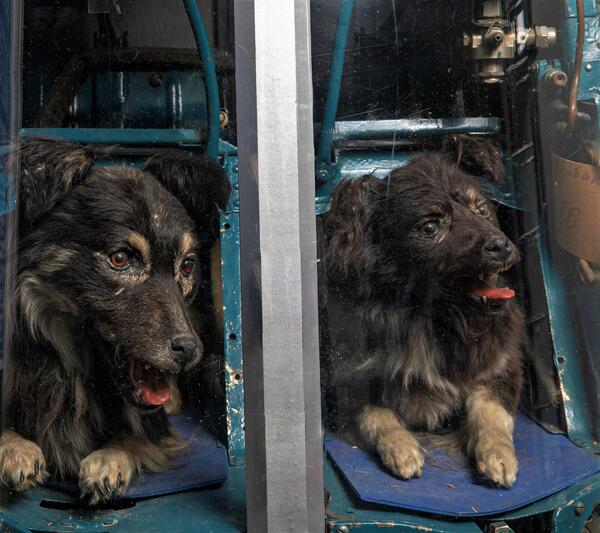A safety module with stuffed dogs is displayed at the Military Medical Museum. This exhibit represents an important stage of biomedical research in outer space.
By the end of the 1940s, scientists had already known how humans and animals reacted to g-loads, vibrations, noise and other difficulties that arose during an airplane flight. But no one could predict what would happen to living organisms in zero gravity.
In 1947, the Scientific Research Institute of Aviation Medicine of the Air Force under the USSR Ministry of Defense developed a research program of biomedical issues associated with flights in the upper atmosphere. Scientists selected about 30 outbred dogs to conduct the experiments: Russian physiologists already used those animals for testing and understood the particulars of their organisms and behavior patterns.
After several months of training in July — August of 1951, the researchers conducted six experimental flights with the dogs at the altitude of 100 kilometers. The test subjects were placed in a pressurized cabin of a geophysical rocket, intended for suborbital flights — that is, flights at a speed slower than needed to enter orbit.
At the first stage of the experiments, the cabin was equipped with a parachute system, but two flights resulted in the death of animals due to design defects in individual elements of the rocket system. At the next stage, in order to ensure a safe ejection and parachute descent, a special equipment was installed in the rocket — a safety module or a pressurized cabin for animals.
Engineers of the research and development enterprise ‘Zvezda’ (‘Star’) developed the module before the beginning of 1957. The cabin looked like a cylinder with convex bottoms. One bottom was removable. A porthole was installed there, it illuminated the cabin and allowed observing the test subjects on the Earth. An automatic feeder, air conditioning and temperature control systems were placed inside the cabin. The dogs’ health condition was monitored using the equipment that recorded pulse rate, respiration rate and blood pressure, and traced ECG. The researchers also measured the temperature and pressure in the cabin.
The test subjects flew in special spacesuits — sealed bags made of three-layer rubberized fabric with a helmet and two sewn sleeves for the front paws. The oxygen supply system consisted of three two-liter oxygen cylinders, which lasted for 2–2.5 hours.
According to the experiment plan, after the launch, the animals were in zero gravity for four minutes. On the last flight leg, the module ejected, the parachute system was triggered, and the dogs landed.
Thanks to the development of pressurized animal cabins, Belka, Strelka and other dogs successfully returned from the orbital flight. The results of the experiments led to a conclusion that a human spaceflight was possible.
By the end of the 1940s, scientists had already known how humans and animals reacted to g-loads, vibrations, noise and other difficulties that arose during an airplane flight. But no one could predict what would happen to living organisms in zero gravity.
In 1947, the Scientific Research Institute of Aviation Medicine of the Air Force under the USSR Ministry of Defense developed a research program of biomedical issues associated with flights in the upper atmosphere. Scientists selected about 30 outbred dogs to conduct the experiments: Russian physiologists already used those animals for testing and understood the particulars of their organisms and behavior patterns.
After several months of training in July — August of 1951, the researchers conducted six experimental flights with the dogs at the altitude of 100 kilometers. The test subjects were placed in a pressurized cabin of a geophysical rocket, intended for suborbital flights — that is, flights at a speed slower than needed to enter orbit.
At the first stage of the experiments, the cabin was equipped with a parachute system, but two flights resulted in the death of animals due to design defects in individual elements of the rocket system. At the next stage, in order to ensure a safe ejection and parachute descent, a special equipment was installed in the rocket — a safety module or a pressurized cabin for animals.
Engineers of the research and development enterprise ‘Zvezda’ (‘Star’) developed the module before the beginning of 1957. The cabin looked like a cylinder with convex bottoms. One bottom was removable. A porthole was installed there, it illuminated the cabin and allowed observing the test subjects on the Earth. An automatic feeder, air conditioning and temperature control systems were placed inside the cabin. The dogs’ health condition was monitored using the equipment that recorded pulse rate, respiration rate and blood pressure, and traced ECG. The researchers also measured the temperature and pressure in the cabin.
The test subjects flew in special spacesuits — sealed bags made of three-layer rubberized fabric with a helmet and two sewn sleeves for the front paws. The oxygen supply system consisted of three two-liter oxygen cylinders, which lasted for 2–2.5 hours.
According to the experiment plan, after the launch, the animals were in zero gravity for four minutes. On the last flight leg, the module ejected, the parachute system was triggered, and the dogs landed.
Thanks to the development of pressurized animal cabins, Belka, Strelka and other dogs successfully returned from the orbital flight. The results of the experiments led to a conclusion that a human spaceflight was possible.



